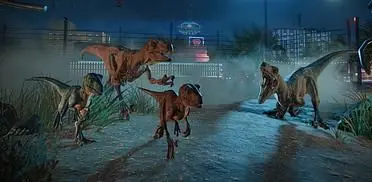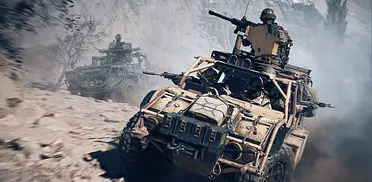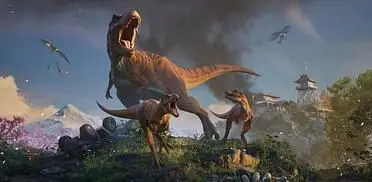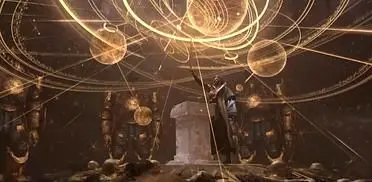It seems like barely a day goes by without another intriguing Kickstarter campaign helmed by former members of the talented team at Irrational Games popping up. The most recent, and certainly one of the most interesting, is Perception, a first-person horror where you play as a young blind woman called Cassie, who must navigate a haunted house, solving mysteries and trying not to get devoured by an invincible, terrifying presence known (fittingly) as The Presence, all the while relying only on her sense of echolocation. Using my own enhanced, almost superhuman senses, I managed to track down Bill Gardner, Perception’s creative director, founder of development team The Deep End Games, and a twelve-year Irrational veteran who worked on several key levels from the original Bioshock, to get the lowdown on the project.
GameWatcher: How did the initial kernel of the idea that lead to Perception come about? Did you always intend to make a horror game?
Bill Gardner: Horror is very much in my blood. My parents owned a video store early in the home video days, so I had access to pretty much any movie I wanted. I was always drawn to horror, possibly from too early an age. I’d shoot little horror films in the backyard with my friends, that sort of thing. I think if you look at the games I’ve worked on, when I was the level designer on Bioshock for the first phase of the project, the levels I spent the most time on were ‘Fort Frolic’, ‘Welcome to Rapture’ and ‘Medical Pavillion’. Those are all paced very differently, with more of a horror edge, which is what I’m naturally drawn to as a designer.
As for the idea itself, I was finishing up a final semester for my master’s degree in human computer interactions, human factors, all that nerdy stuff. There was one class held by a professor who is hugely well-respected in UX (User Experience) circles, he was teaching and prototyping, and at the end of one class he said; “Okay, everyone’s going to walk out of here and by the time you get to your car, you’ll have come up with a brilliant idea.” I love all that stuff, those kinds of weird challenges and constraints. So by the time I got to my car I had the general idea for a horror game. It was slightly different, it didn’t have the blind notion, but the premise of the story was there.
So I started reaching out to my friends and former colleagues, people like Jim Bonney (responsible for the music and sound design on Bioshock Infinite, as well as several other high-profile games). Started to pitch ideas and talk them through, and it just became more and more clear that I had to do this. So that’s where the idea came from, and then I spent the next semester at Bentley doing research into blindness, into how blind people use technology. Spent several days with my phone using only the accessibility options for partially-sighted people, text-to-speech and that kind of thing. Just really tried to immerse myself in that world.
GameWatcher: Yeah, I feel like people who aren’t visually impaired really have no idea about the limitations or abilities of people who are. That’s an interesting thing to look at and explore in a video game.
Bill Gardner: That’s the idea, certainly, I’ve certainly been inspired by all the research I did, it’s been amazing. I found a guy called ‘the blind movie critic’, he does little one or two minute reviews on the latest Hollywood releases, and it’s a cool thing to find out what someone who has such a different perspective on what’s happening thinks about something you’ve seen. Then I found out about Daniel Kish, you might have heard of him, he does a lot of talks and presentations, he actually uses echolocation. He mountain bikes. He’s completely blind, and he mountain bikes. So I kind of fell in love with that perspective, and thought this was a great opportunity to try to approach things differently. If you’re going to put someone in someone else’s shoes, why not make that an interesting pair of shoes to fill, rather than the same thing every other first-person game does?
GameWatcher: How about making the game accessible to blind or visually impaired gamers? I realise that’s a difficult thing to do, but is it something you’re looking into?
Bill Gardner: With the visually impaired side of things we’re definitely going to take some steps, I don’t know how exactly far we’re going to be able to go, but I think there are a lot of pieces here that are going to make the game more accessible for the visually impaired. I don’t know what level we’ll be able to hit, but most of the text in the game is text-to-speech, we’re going to have subtitles with bigger fonts, follow all the accessibility guidelines where we can. It’s tough being a smaller studio, obviously. As for those who are completely blind, I spent a lot of time trying to look for ways to make that work, and I haven’t found a solution I’m happy with. If you’re going to do it, I think you should do it right, I don’t think it does anyone any favours if you just do it to tick that off on the box, just to say “oh, yeah, totally playable for blind gamers.”
I don’t know if you’ve ever heard of Shades of Doom? It’s a game that’s completely audio, and I’ve seen Youtube videos of people playing it. It’s pretty fascinating, it’s on the Doom engine. You run around, and when you target an enemy you get a little audio feedback, when you’re against a wall it gives you a little beep, that sort of thing. But I think… my core goal is to tell a story that raises awareness and gives people a little bit of a different perspective; the way our hero Cassie uses her phone, the way she uses echolocation, I wanted to capture a bit of that feel. Obviously it’s a game, and they tend to be visual. It’s something I’ve looked into, and will continue to do so, but I want to be careful about making promises, and I don’t want to commit to something unless it’s right. For now, I’m not happy with the ideas or solutions we’ve tested.
GameWatcher: Much like the levels you worked on in Bioshock, the choice of location is key to Perception. How did you go about choosing the right setting, the right architectural style? I know the house in the game is located near Gloucester, Massachusetts, which is near where you live.
Bill Gardner: Absolutely. I grew up here, and there’s a lot of inspiration all around. There’s something in the air up here, something very different. A lot of famous horror has been set here. It’s not quite Gothic, but there’s a unique feel to the land and architecture here. We spent quite a bit of time researching structures and buildings up here, we visited Salem, we visited Danvers, we went driving around Gloucester. Some of these houses are hundreds of years old, which is obviously nothing close to Europe, but for the US it’s very different. Most of the country is a few decades, maybe a couple of hundred years or so old, so it’s very different for this country. So yeah, just tonnes and tonnes of research, trying to get as much of that early architecture, trying to soak that in and capture that feeling. Growing up, living around here, so sort of draw from all these different pieces of memory and inspirations, so it’s kind of a smorgasbord of all that.
GameWatcher: The idea of an invincible nemesis that you can’t fight back against is something we’ve seen relatively recently in Alien: Isolation. In that game Ripley had a bunch of tools she could use to fend it off, what kind of options does Cassie have against The Presence?
Bill Gardner: Isolation was obviously a huge inspiration. I think as we started to dig into this game, someone brought it up on the team and I checked it out. There’s a lot of that similar feeling that I love, those guys did an amazing job. I’m a huge fan of the game, especially some of the industrial design, my god. It’s amazing to be able to make something as nerdy as those old-school green computer monitors cool, but they did it. In Perception, when you see The Presence for the most part you’re going to want to run and hide, but many of the objects that look like they can be picked up in fact can, and you can throw those to distract it. Then there are what we call ‘Sound Bombs’. You can go up to the grandfather clock and change the dial to make it go off, create little timed distractions.
There are a few little ideas like that, but for the most part it’s about being very careful, very observant. It’s almost like that Red October film; you’re pinging your sonar to see what’s out there, and it’s kind of doing the same thing. Being observant, and then trying to find the right way to explore and the right time to venture forth. As you progress there are little twists, so there are additional elements outside of The Presence that will throw you a curve ball as well.
GameWatcher: One thing I felt about Isolation was that the game felt a little bloated, and maybe played out the mechanics it relied on a bit too much. How do you go about making sure Perception never feels like it’s retreading the same ground too much?
Bill Gardner: So I’m going to step into a total trap here, even though I know that wasn’t the intent. I loved Alien: Isolation, but I felt like so many other first-person games, it was too long. That’s number one. We’ve been very careful about making sure there’s enough freshness and enough new content, new things to see, that it’s not going to be, like “I’ve seen this, let’s get going”. In some cases that means we won’t stick around in a single chapter longer than it feels welcome. That’s the biggest way of combating it, I don’t exactly know the total length yet… I hate that question. I hate the ‘how long is your game’ thing, I know you didn’t ask that, but right now we’re targeting somewhere around five or six hours. That’s one of the key differences, but it’s also making sure there’s enough wrinkles and curveballs; you get comfortable with sound and echolocation, and then we introduce The Presence, and then we introduce something else, that I won’t talk about here, to change the way you explore. Building on what you’ve learned without overstaying our welcome.
GameWatcher: That’s a problem with a lot of recent horror games. They tend to be very effective at the start, but due to this perceived need for a huge running time, they end up far too bloated.
Bill Gardner: I one hundred per cent agree with that. Look at something like Ico, which may have actually been a little bit too long, but people remember it as being great. It’s a short game, a singleplayer game, but man oh man, if they had made it an hour or so longer I would probably not have walked away with the same feeling, the same love for it. That’s important. There’s a lot of games, like the Portal series, where you just walk away thinking “okay, that was a great experience”. You never hit the wall and feel like it’s tedious and you’re done with it. It’s critical that we avoid that, I don’t ever want to hit that spot. So yeah, we’ll watch that very closely. We’ll never do the padding thing, add whatever kind of distractions we can just to bump up the length.
GameWatcher: In terms of the storytelling in the game, how do you handle that side of things? Do you use cutscenes, or does most of the story happen in-play?
Bill Gardner: So I haven’t thrown down the gauntlet and said “we’re going to do absolutely no cutscenes”, but that’s definitely how we’ve written it. It’s been a very clear goal that Amanda (Gardner, co-founder of The Deep End Games, writer/producer, and Bill’s wife) and I have had, and we’ve spoken to the team about it. Listen, for some games cutscenes are great, but it’s not right for this game. So it’s all told in real-time, in the world. There are very familiar Irrational elements there, the story is told through the world, through vignettes, ghosts, letters you pick up and translate text-to-speech through your smartphone. There are other ways to exposit and pull information from the world. It’s about trying to find some different ways to do that, hopefully new and exciting ways. But yeah, cutscenes are definitely something we’re trying to avoid.
GameWatcher: Obviously the game sounds perfect for VR. I assume that’s something you’d like to add support for, if possible?
Bill Gardner: Oh, man. I have this silly little picture I’ve shared a few times, which is of me back in 1999 when I was driving across-country. We stopped off in Vegas and they had this little VR arcade, and I was playing with my friend. This was my first time playing it, it had been a few years since VR had kind of gone away again after whatever the heck killed it off. We were playing a Star Wars game, Dark Forces or something, and it was so immersive. I remember my friend was next to me, whacking away at an enemy as Darth Vader or whatever, and I was trying to turn to face him in-game. I was trying to turn to my right, and I just couldn’t and I was yelling to the guy running the arcade that the thing was broken. Then I felt this sharp pain in my neck, took the helmet off and I just had my head turned right round to the right, to the point that I physically couldn’t move any further. I’d completely left my body for a couple of minutes. I remember thinking, and this is fifteen or sixteen years ago, that I really hope this tech comes back, just to capture that feeling. So yeah, I agree that this game would be a great fit. We have it as a stretch goal now, and I really hope we hit it, because I think it would be a uniquely immersive experience. For VR in general, but in particular for this title, to see the world with this effect and this perspective, that would be really rad.
Many thanks to Bill for speaking to us. As of this moment Perception has raised $69,212 from a $150,000 goal, with 24 days left to go on the Kickstarter campaign.








